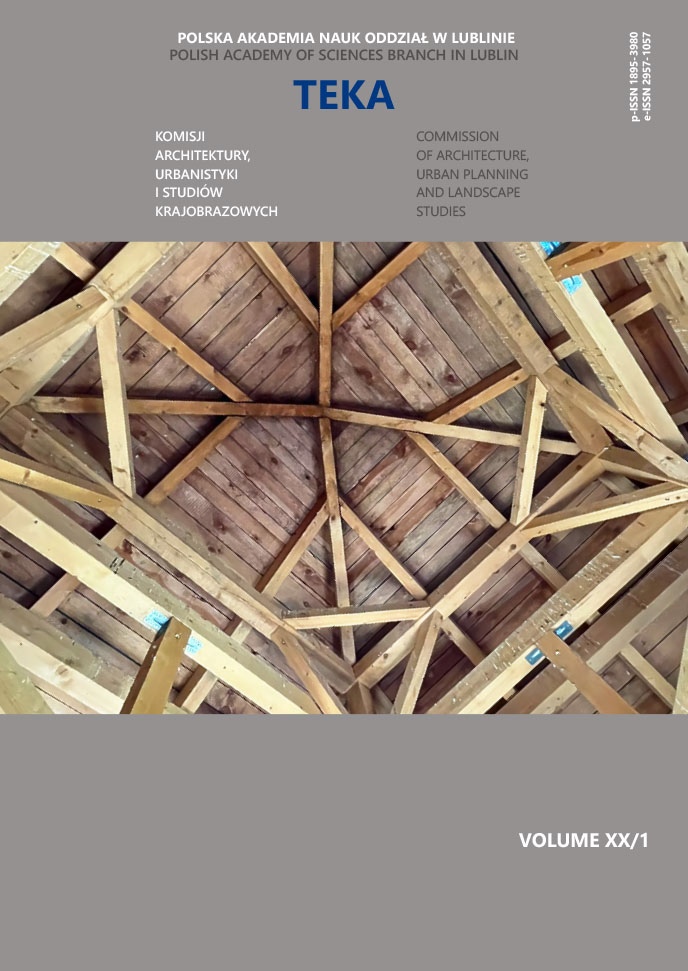Rysunek odręczny podstawowym środkiem wyrazu plastycznego w procesie edukacji przyszłych architektów a współczesna technologia komputerowa
Agnieszka Chęć-Małyszek
a.chec-malyszek@pollub.plKatedra Architektury, Urbanistyki i Planowania Przestrzennego, Wydział Budownictwa i Architektury, Politechnika Lubelska (Polska)
https://orcid.org/0000-0001-6004-0635
Abstrakt
Rysunek odręczny należy do jednych z najwcześniejszych i zarazem najważniejszych umiejętności człowieka. Zaliczany jest do najprostszych form zapisu myśli oraz informacji już od wczesnego dzieciństwa, który pozwala komunikować się bez użycia słów. Jest on pierwszą, werbalną formą kontaktu ze światem zewnętrznym za pomocą, którego ilustrowane są uczucia, emocje i pragnienia. Jest czymś, co pozwala zobaczyć otaczające piękno, dostrzec szczegóły, poznać budowę i strukturę materii i na długo zachować obraz w pamięci. W artykule poruszono zagadnienia związane z procesem kształcenia w zakresie rysunku odręcznego na kierunku architektura na Wydziale Budownictwa i Architektury Politechniki Lubelskiej. W niniejszej pracy rysunek został przedstawiony, jako podstawowe narzędzie umożliwiające zaprezentowanie własnej koncepcji projektowej przyszłym inwestorom, który uczy spostrzegania, analizowania oraz rozwija wyobraźnie twórczą i przestrzenną. Przyjmując, że nauka rysunku odręcznego stanowi podstawę wszelkich działań artystycznych, w artykule podjęto próbę zbadania istoty rysunku odręcznego w procesie kształcenia przyszłych architektów na Politechnice Lubelskiej. W literaturze przedmiotu poruszona została kwestia wartości przekazywanych za pośrednictwem rysunku odręcznego oraz dokonano porównania go ze współczesnymi, zaawansowanymi programami komputerowymi.
Słowa kluczowe:
rysunek odręczny, współczesna technologia komputerowa, środek wyrazu plastycznegoBibliografia
Alberti L. B.,„Renesansowa teoria piękna, cz. 1” Available: https://niezlasztuka.net/o-sztuce/leon-battista-alberti-renesansowa-teoria-piekna-cz1/ [5 April 2017].
Google Scholar
Balcerzka R., M.Ozrechowski, J.Pętkowska-Henlek, M.Suffczyński, A.Sufiński, T.Trzupek, Rysunek architektoniczny w praktyce, czyli jak patrzeć ze zrozumieniem, PWN, Warsaw 2019, p.7, 170−176.
Google Scholar
Białkiewicz A., O rysunku architektonicznym, Teka Kom. Architektura i Urbanistyka Studia Krajobrazu – OL PAN, 2006,p. 53−60.
Google Scholar
Benkari N., Boudidah M., Architectural education and cultural context in the uae: challenges and opportunities, Alma Cipta Vol 7 (2), December 2014, 51−62.
Google Scholar
Gomółka J., Architectural drawing as a means of communication, „Czasopismo Techniczne. Architektura” 2015, R. 112, z. 4-A,191−194.
Google Scholar
Hansen D., “Architecture and pencil”, [w:] M.J. Żychowska [ed.], Challenges of 21st century. To draw, to paintor to use a computer, Vol. 1, Wydawnictwo PK, Cracow 2015, 48−49.
DOI: https://doi.org/10.1109/MC.2015.306
Google Scholar
Hollanda de F., Dialogi rzymskie (1548), fragment w: Disegno — rysunek u źródeł sztuki nowożytne. p.125 Available: https://www.szkolnictwo.pl/szukaj,Rysunek [Accessed:20 November 2015].
Google Scholar
Makowska B., The significance of sketches in the education of architects and in the development of their professional skills, „Czasopismo Techniczne. Architektura” 2015, R. 112, z. 4-A, 17−24.
Google Scholar
Mełges H., Freehand drawing as an important skill for an architect and students of architecture, [w:] M.J. Żychowska (red.), Challenges of 21st.
Google Scholar
Autorzy
Agnieszka Chęć-Małyszeka.chec-malyszek@pollub.pl
Katedra Architektury, Urbanistyki i Planowania Przestrzennego, Wydział Budownictwa i Architektury, Politechnika Lubelska Polska
https://orcid.org/0000-0001-6004-0635
Statystyki
Abstract views: 193PDF downloads: 305
Licencja

Utwór dostępny jest na licencji Creative Commons Uznanie autorstwa – Na tych samych warunkach 4.0 Miedzynarodowe.




